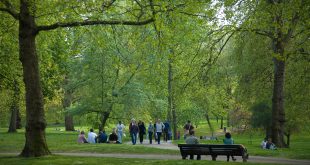Julie Broch
For three weeks, protesters in Mauna Kea, Hawaii, have been grouping across the slopes of Mauna Kea, the tallest mountain in Hawaii, fighting to stop a giant telescope from being built.
A professor at the University of Hawaii observed the large gathering at the roads that lead up to the peak of Mauna Kea. He viewed it as an opportunity to form a Hawaiian-led education system by offering classes to protesters with the help of other educators at the site of the protest.
The professor, Presley Keʻalaanuhea Ah Mook Sang, is a Hawaiian language instructor at the University of Hawaii at Manoa. She came up with the idea as she noticed that the crowd of protesters was growing exponentially.
The classes, held at Puuhuluhulu University, focus on topics such as indigenous rights, history, and many other subjects.
“The morning [classes are geared towards] more indigenous peoples and native rights and towards afternoon is more Mauna-focused,” Ah Mook Sang said. “They share about the place names, they share about the history with development, why the Mauna is sacred, they share different olis [chants] written just for the Mauna.”
Mauna Kea is Hawaii’s tallest mountain, standing at 13,796 feet above sea level. Astronomers say Mauna Kea is the perfect place to construct the $1.4 billion 30 meter telescope, which they explain will be able to look back in time 13 billion light-years, around when the universe was first created.
The protest is part of a long battle over sites where many observatories have already been built. Native Hawaiians believe that Mauna Kea is sacred and they will not allow it to be destroyed by human construction.
Hawaii Gov. David Ige rescinded an emergency proclamation allowing law enforcement to close off parts of Mauna Kea and to use National Guard troops to send construction equipment up to the mountain. The decision came as two tropical storms were heading toward Hawaii.
At a news conference, Ige stated, “For the safety of all involved, we want to de-escalate activities.”
However, this has not hindered the dozens of people gathering daily at Kipuka Puuhuluhulu to learn about a variety of subjects taught through a Hawaiian perspective.
“When we look at this mist we’re not just seeing the mist, we’re seeing Lilinoe, who is one of the goddesses who live on Mauna Kea,” says Kaipu Baker, who taught a language class at Kipuka Puuhuluhulu. “You can only access that if you know the language and the stories embedded in the language.”
Noelani Puniwai, an assistant professor at the University of Hawaii at Manoa, who taught about climate change at Puuhuluhulu explained that Mauna Kea is sacred to Hawaiians for several reasons, including a genealogical connection, the fact many Hawaiians bury their dead there, and its effects on Hawaii’s rain cycle.
Baker, the voice of Maui in the Hawaiian language version of Disney’s Moana, is starting a master of fine arts Hawaiian theater program at the University of Hawaii this fall. He said he sees the protest site as a model for the self-determination of Hawaiians.
“When I look at this, I think this is nation-building,” Baker said.
Ah Mook Sang hopes to keep the spirit of Puuhuluhulu alive and expand community-led school to the other islands, where there’s already interest forming.
 Tempus Magazine By Students, For Students
Tempus Magazine By Students, For Students 



